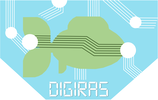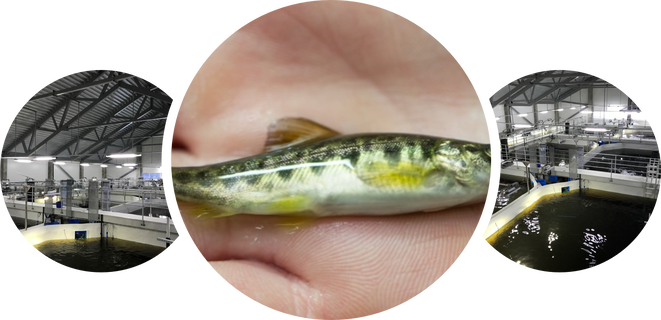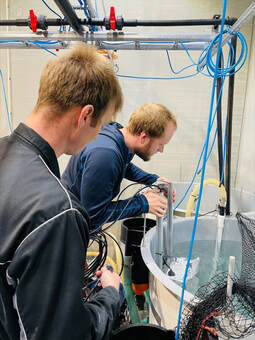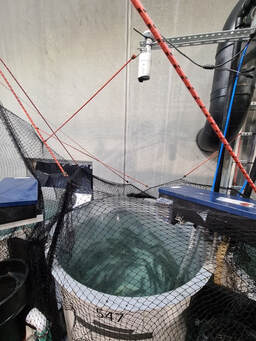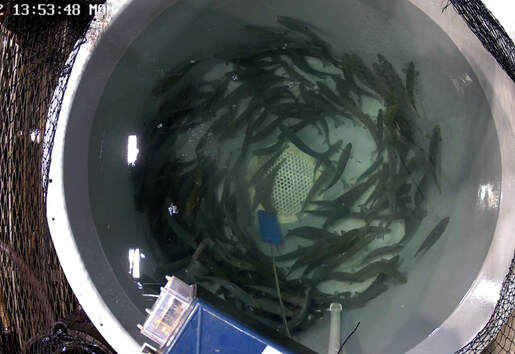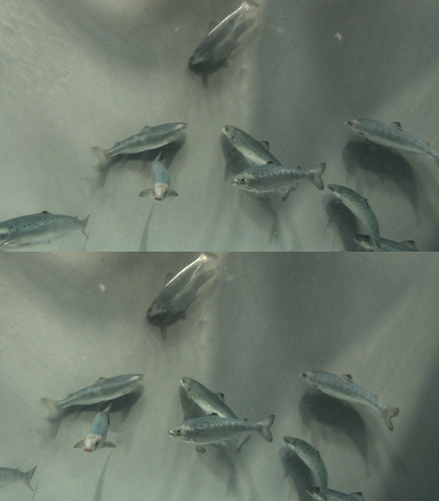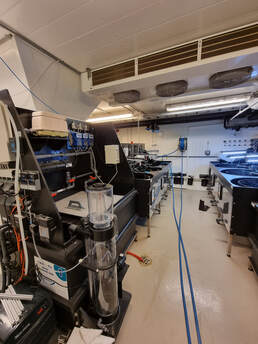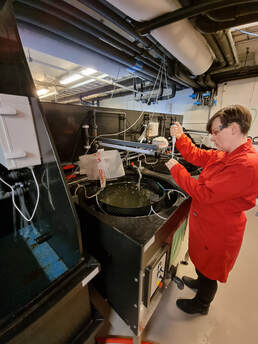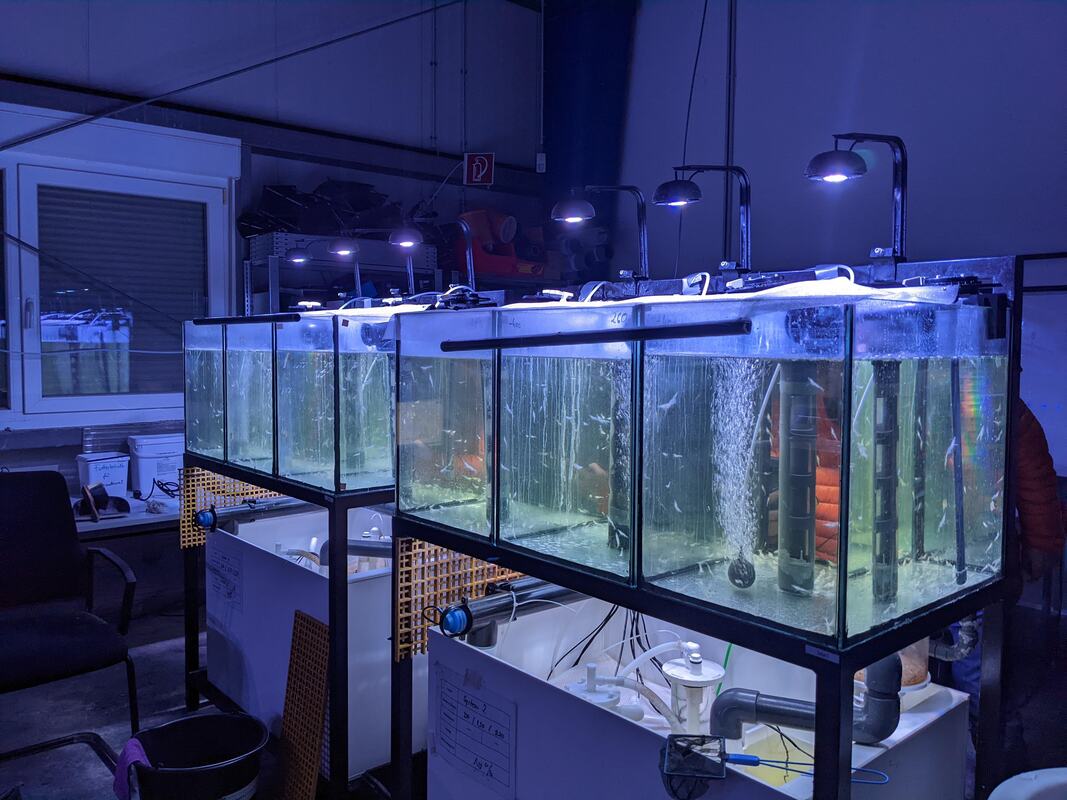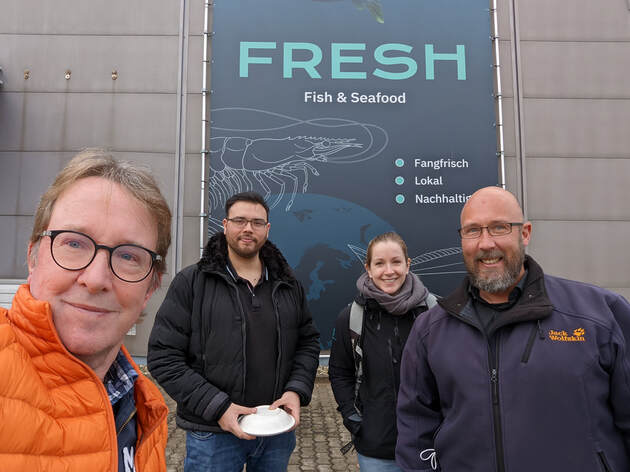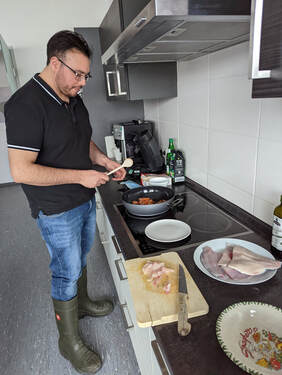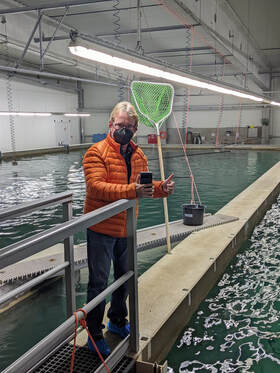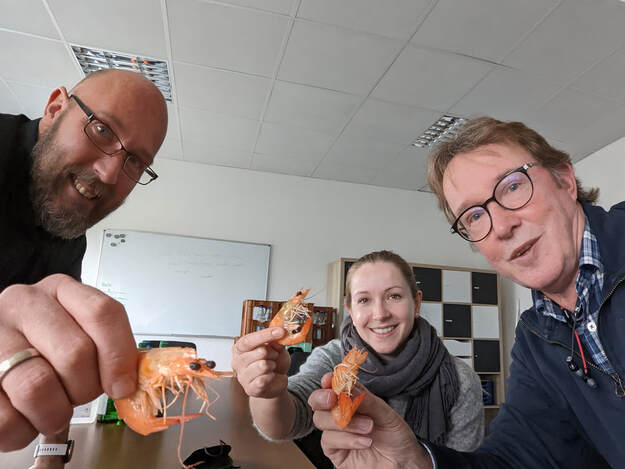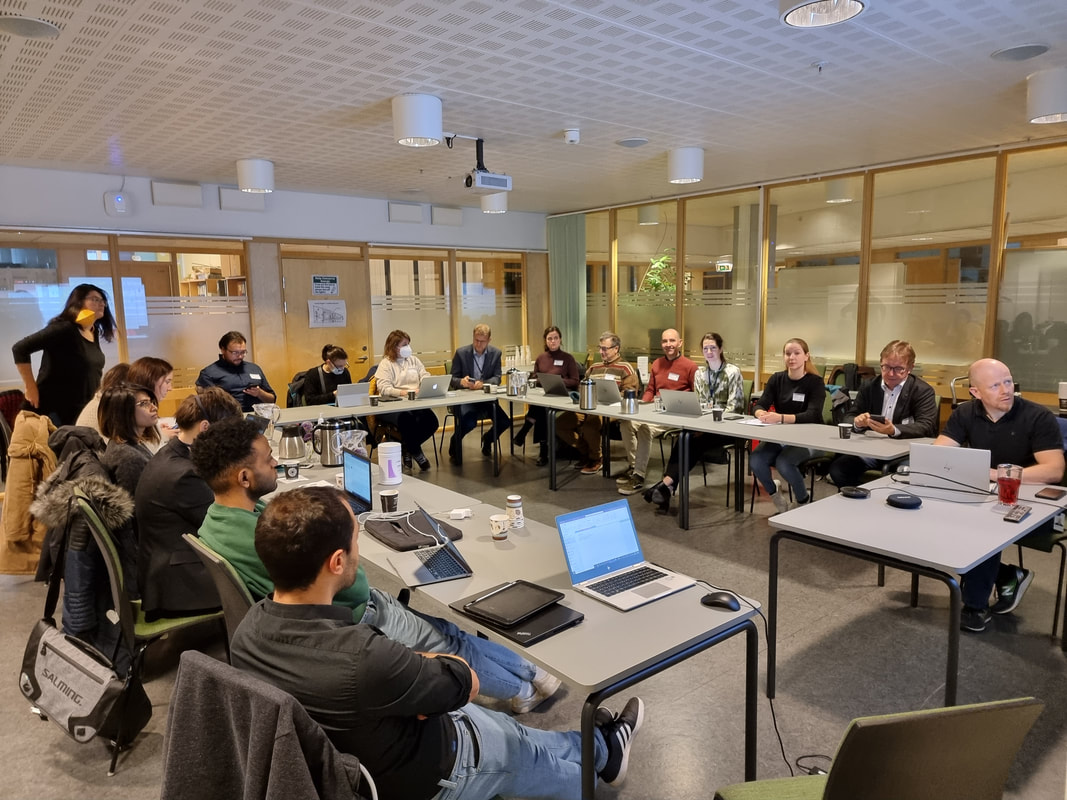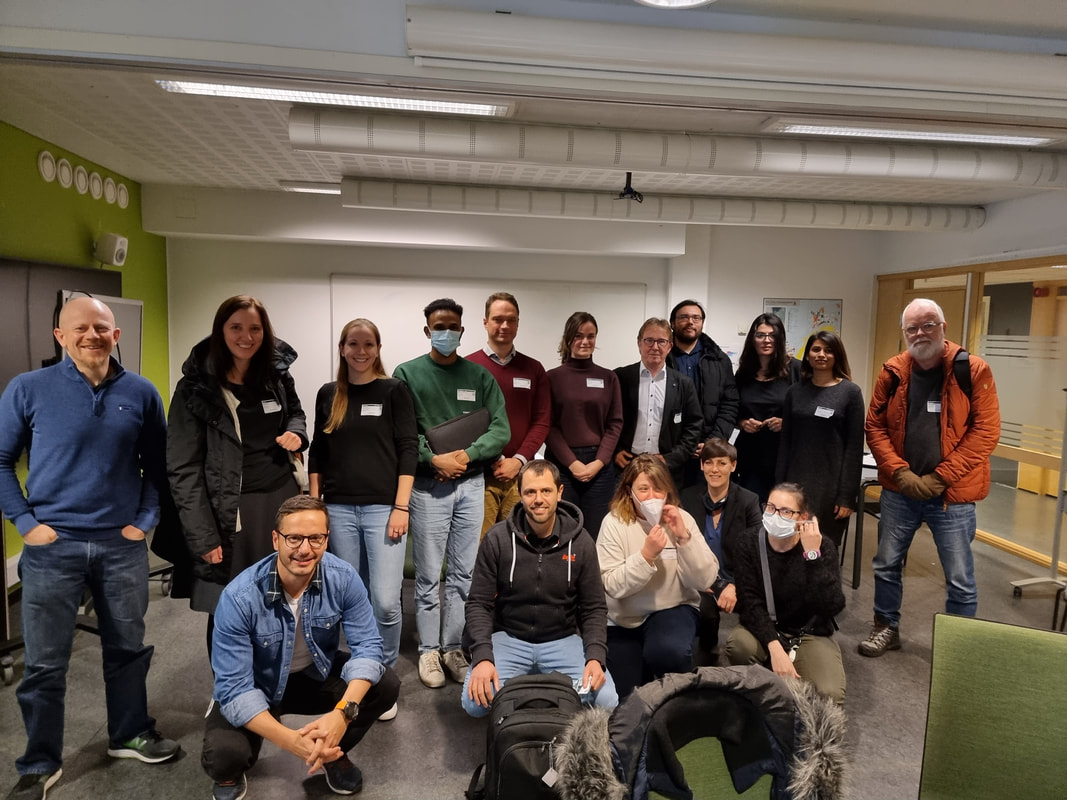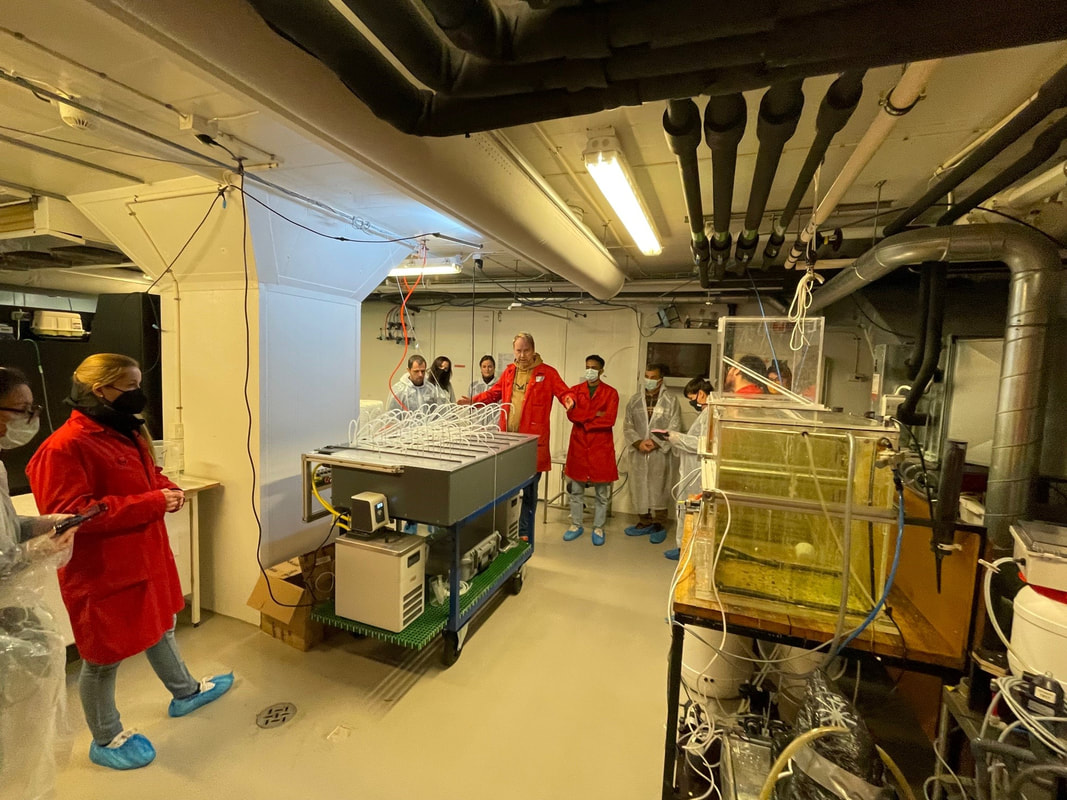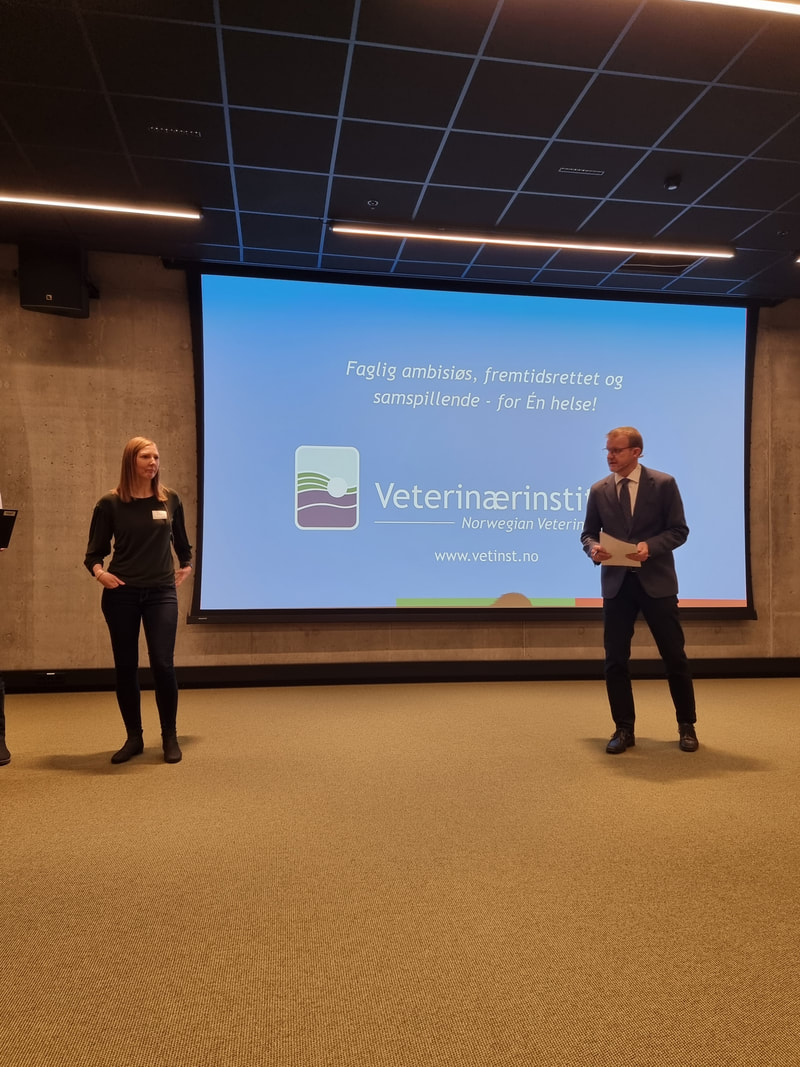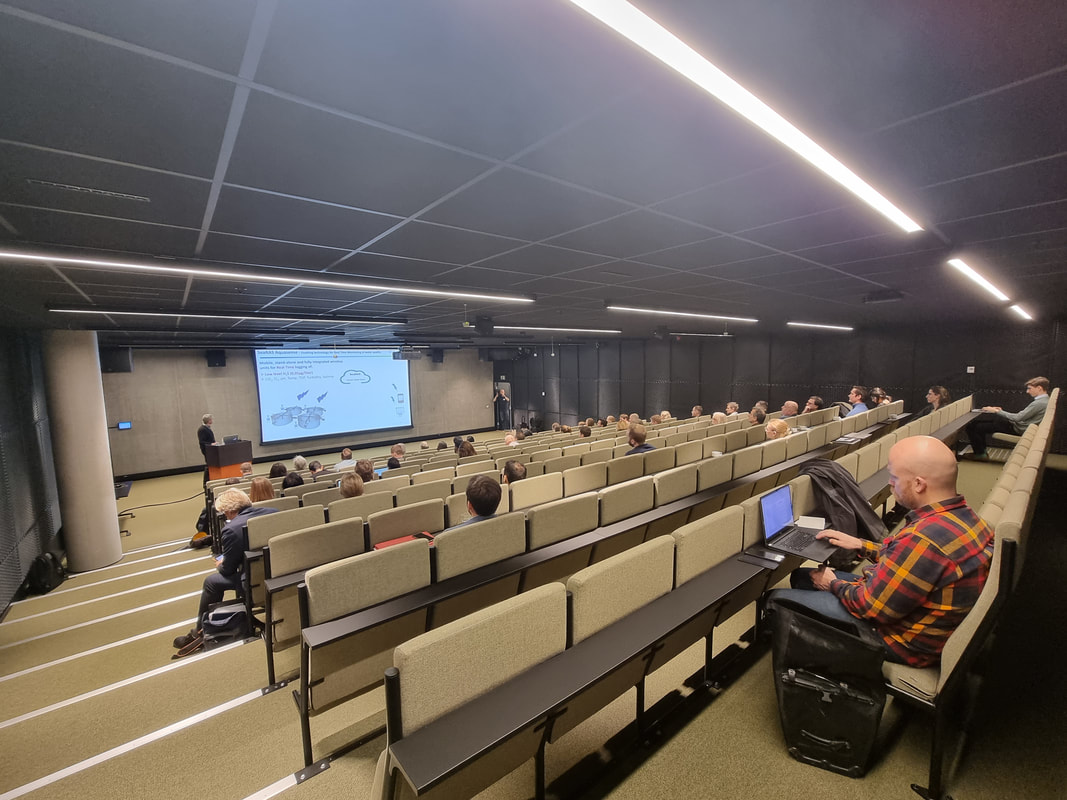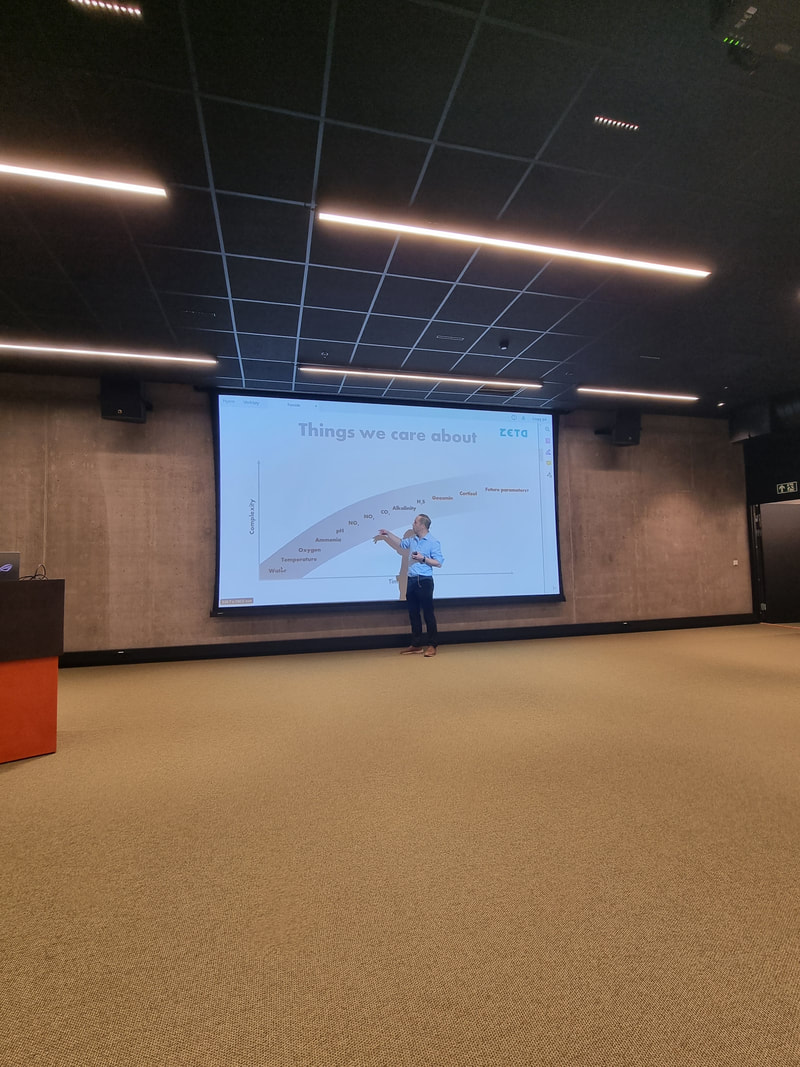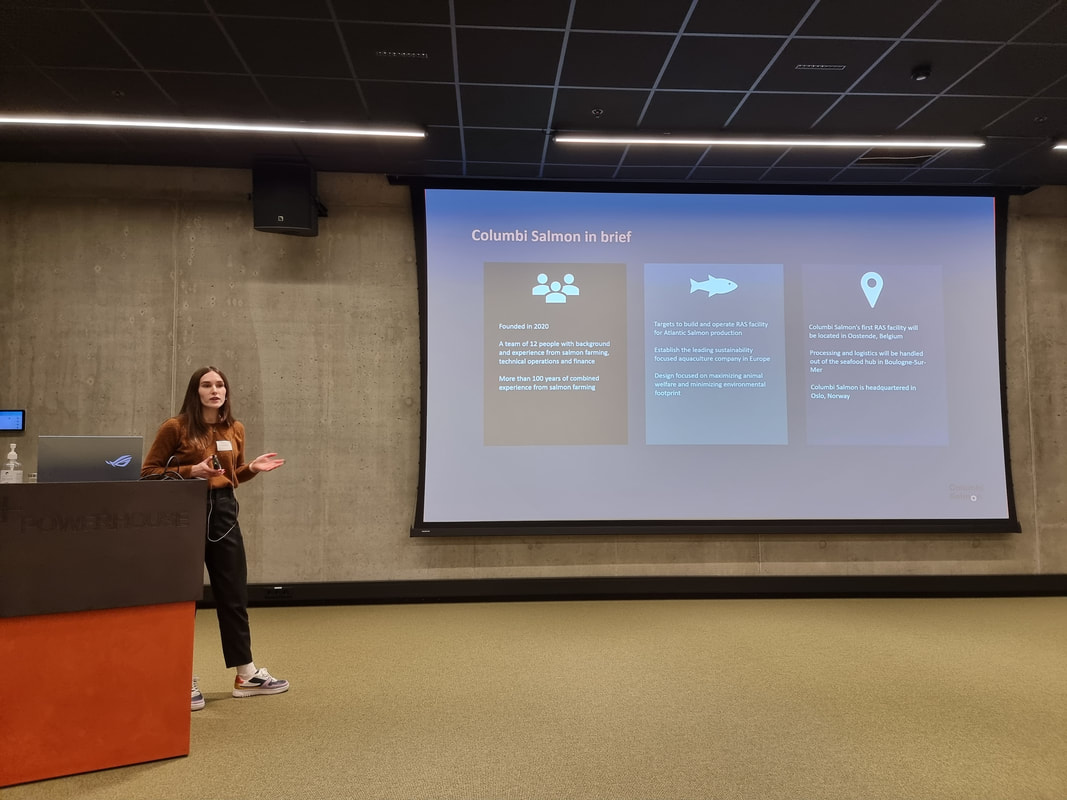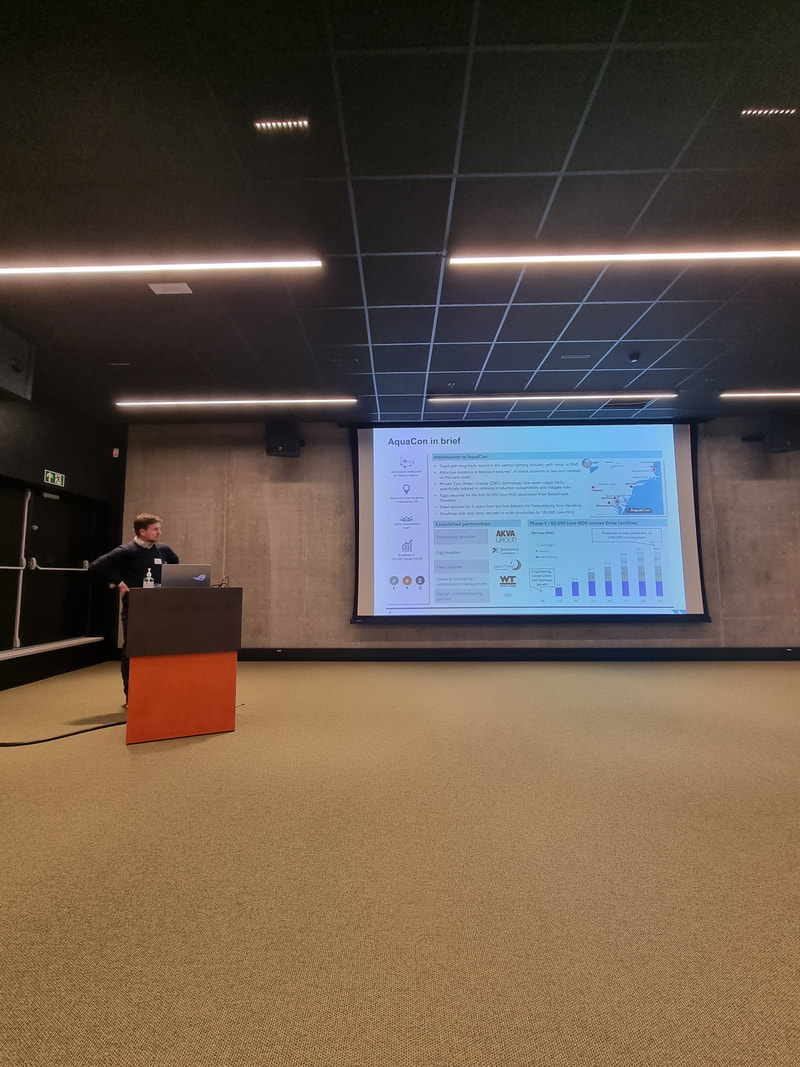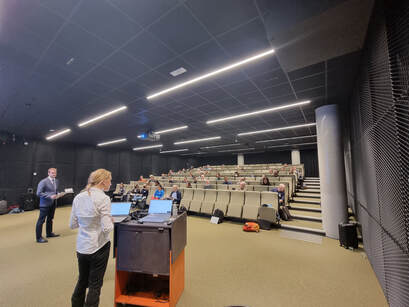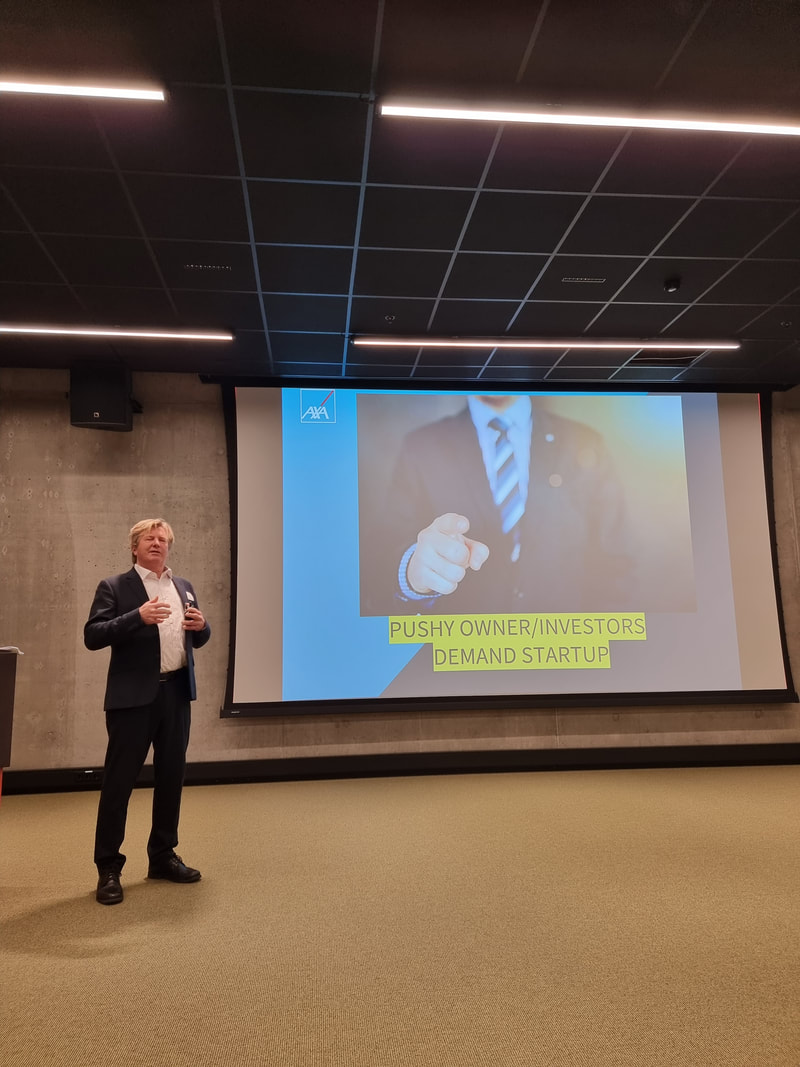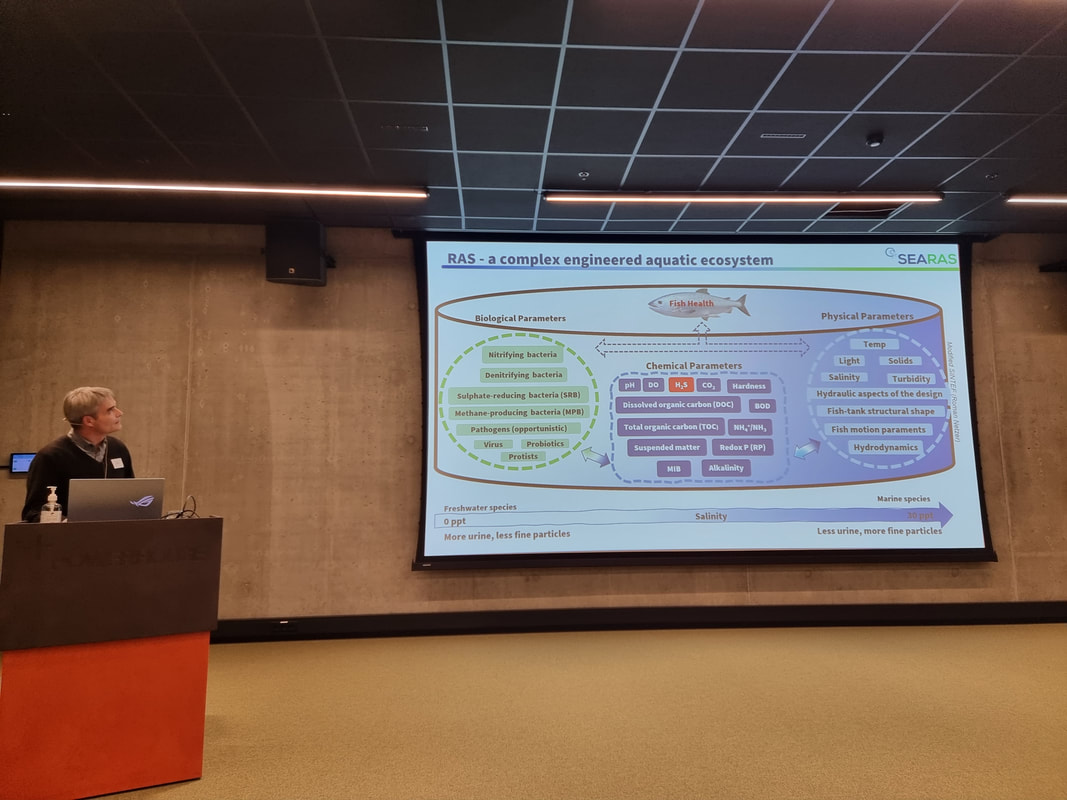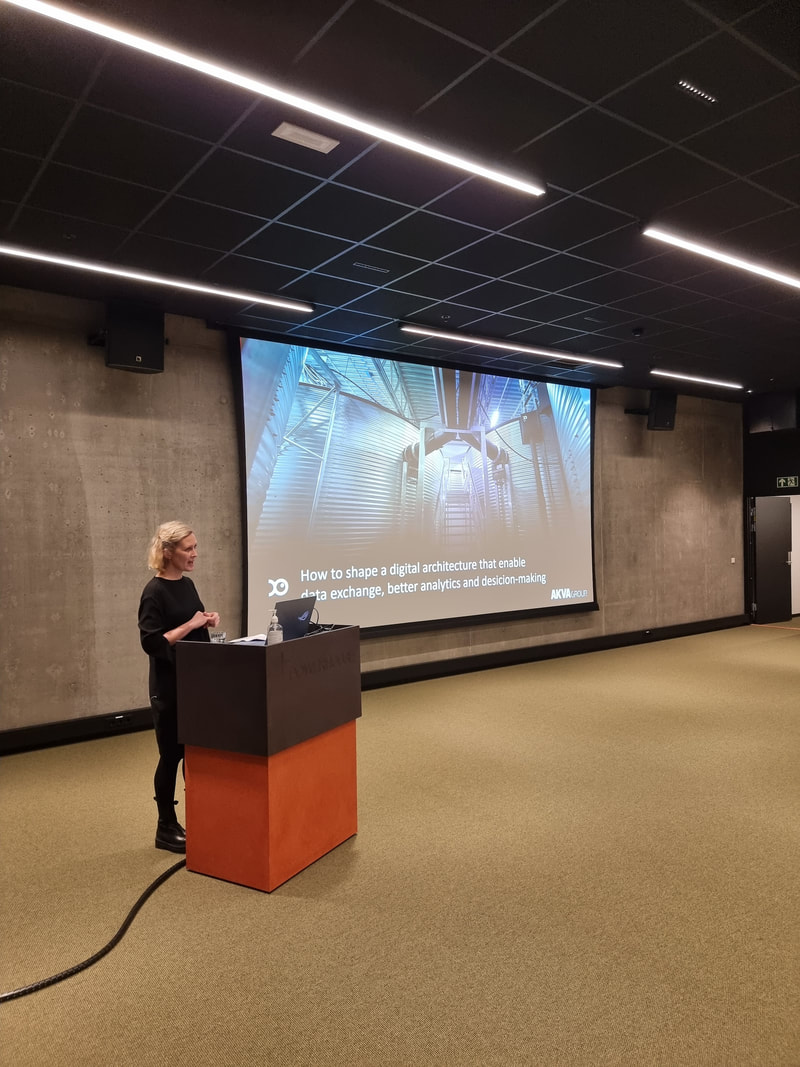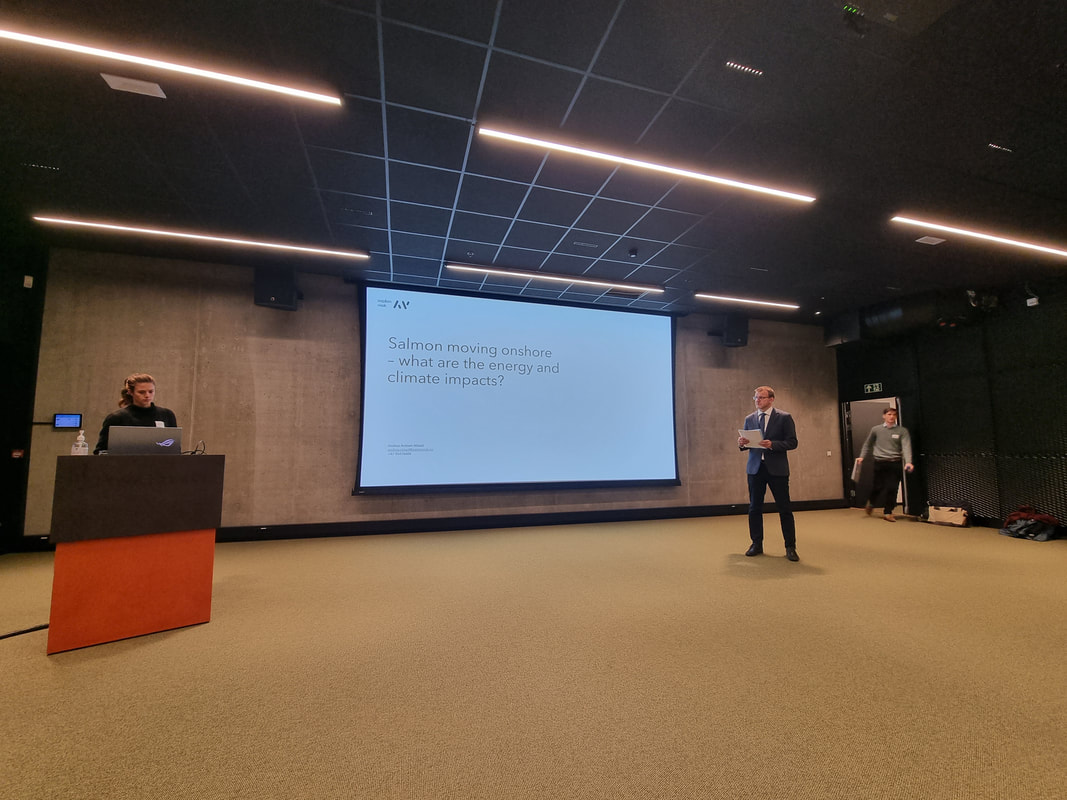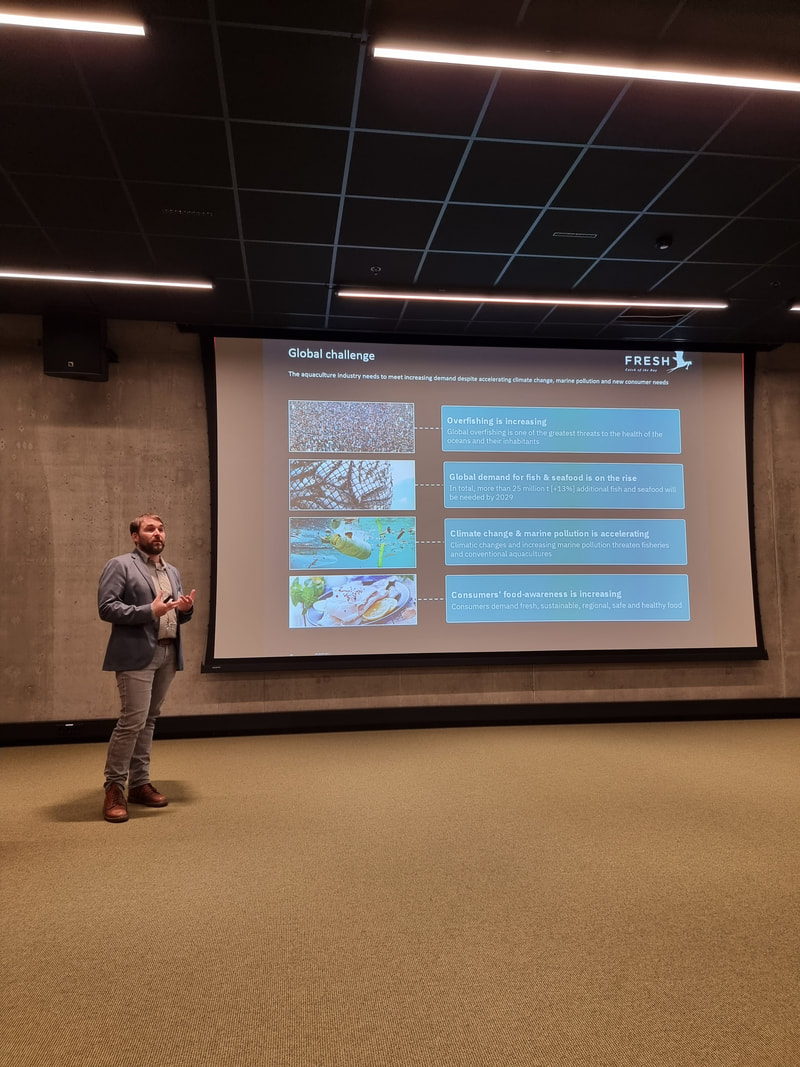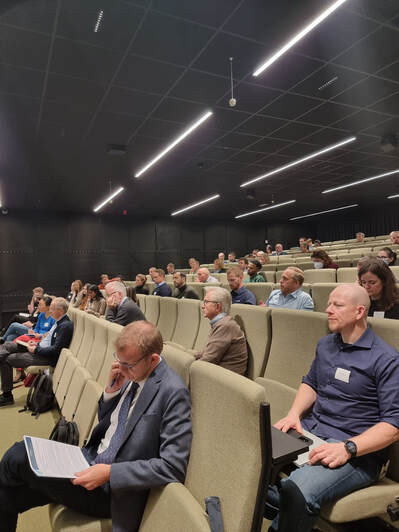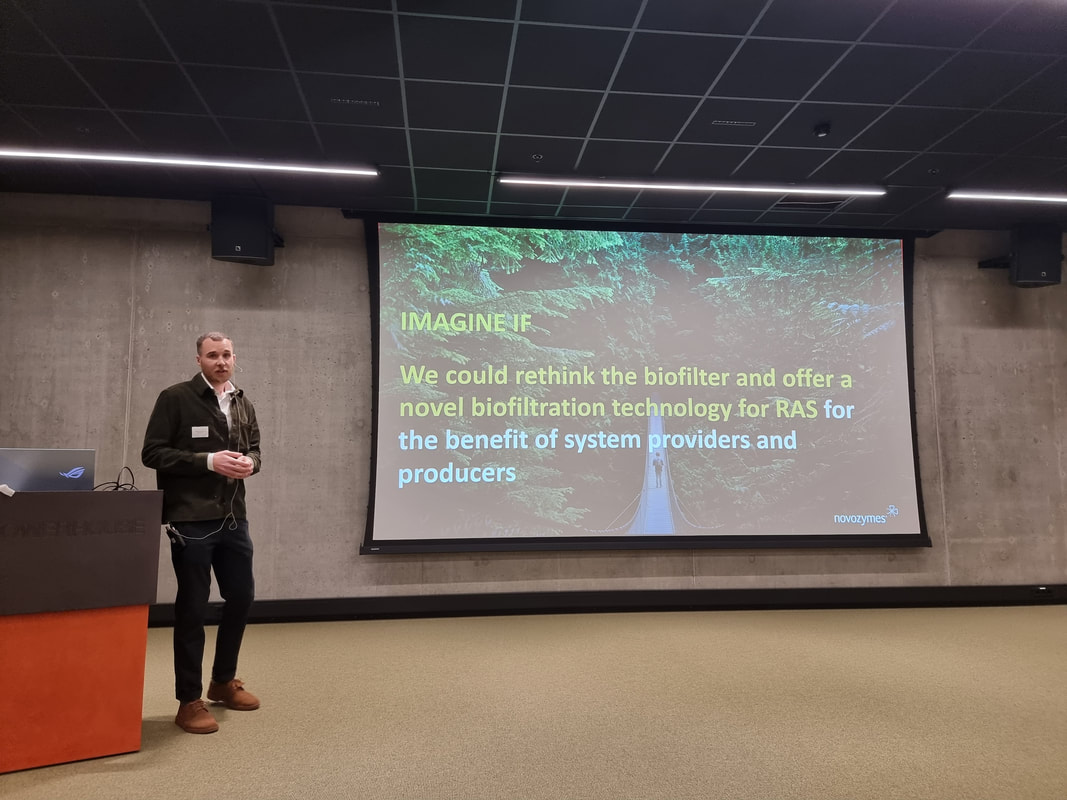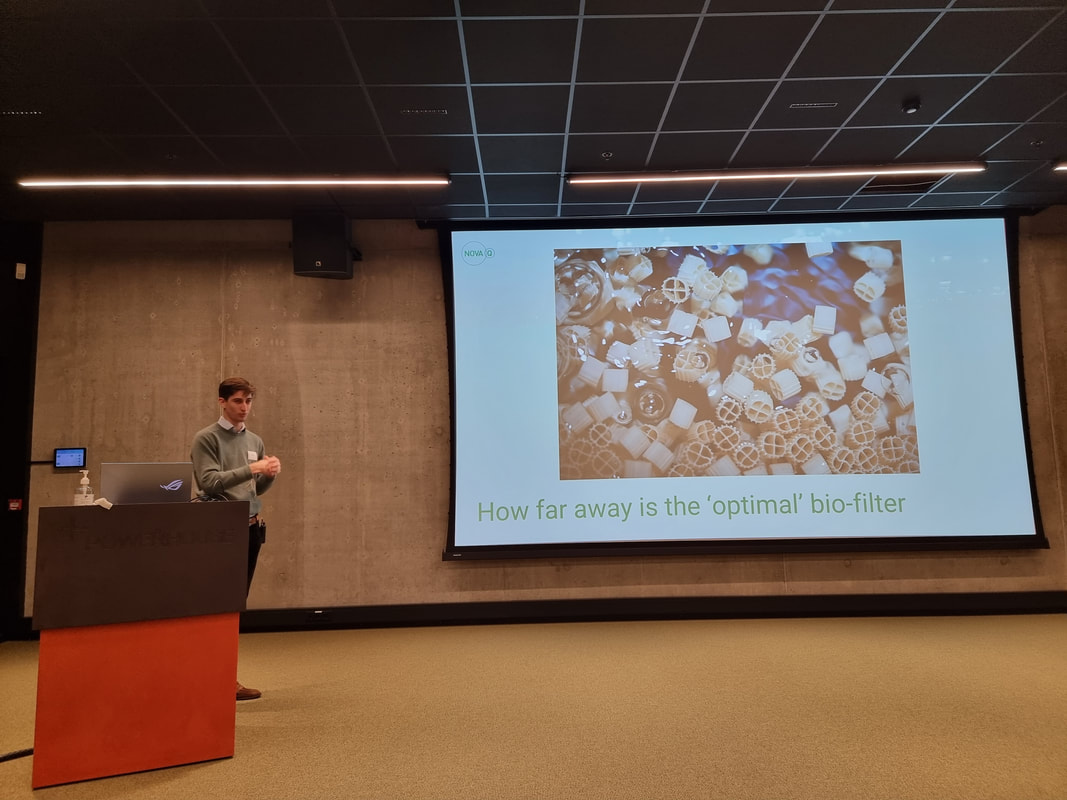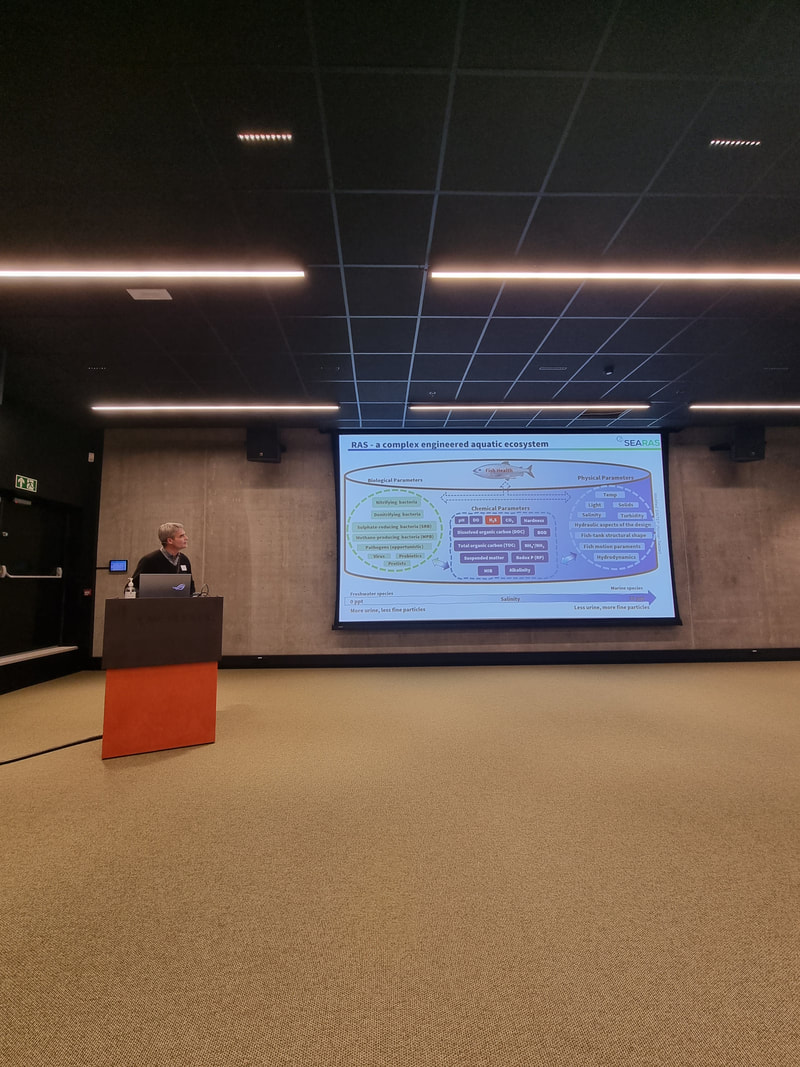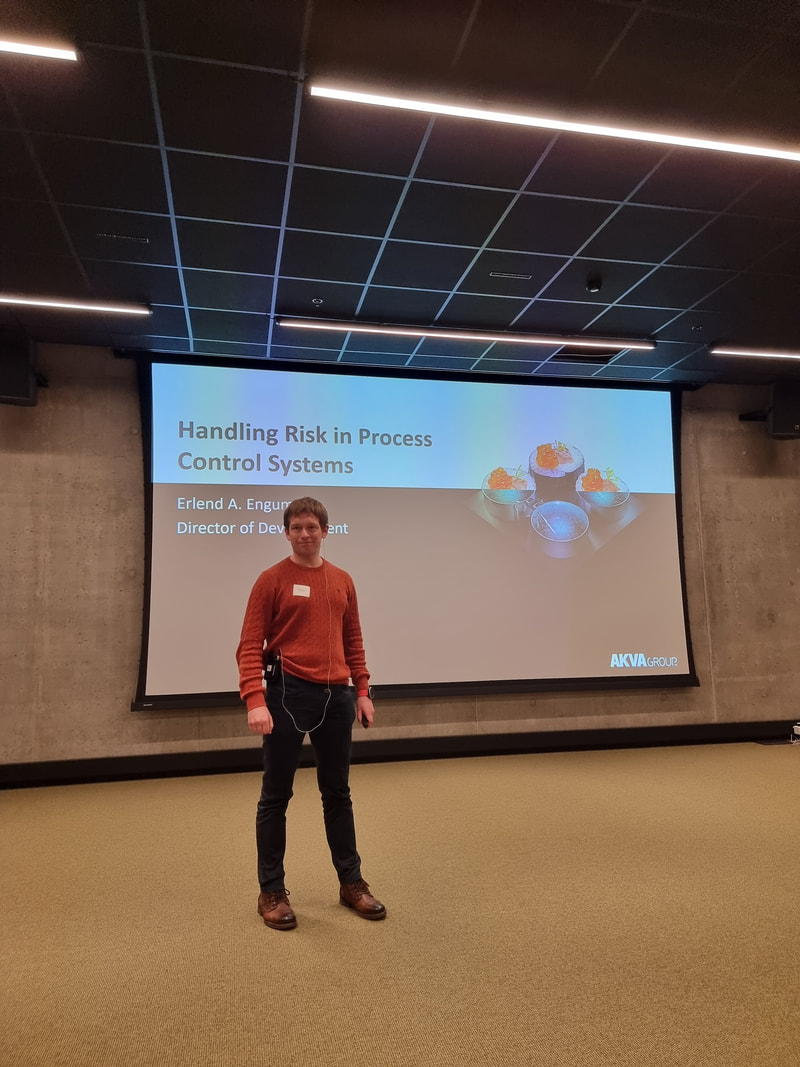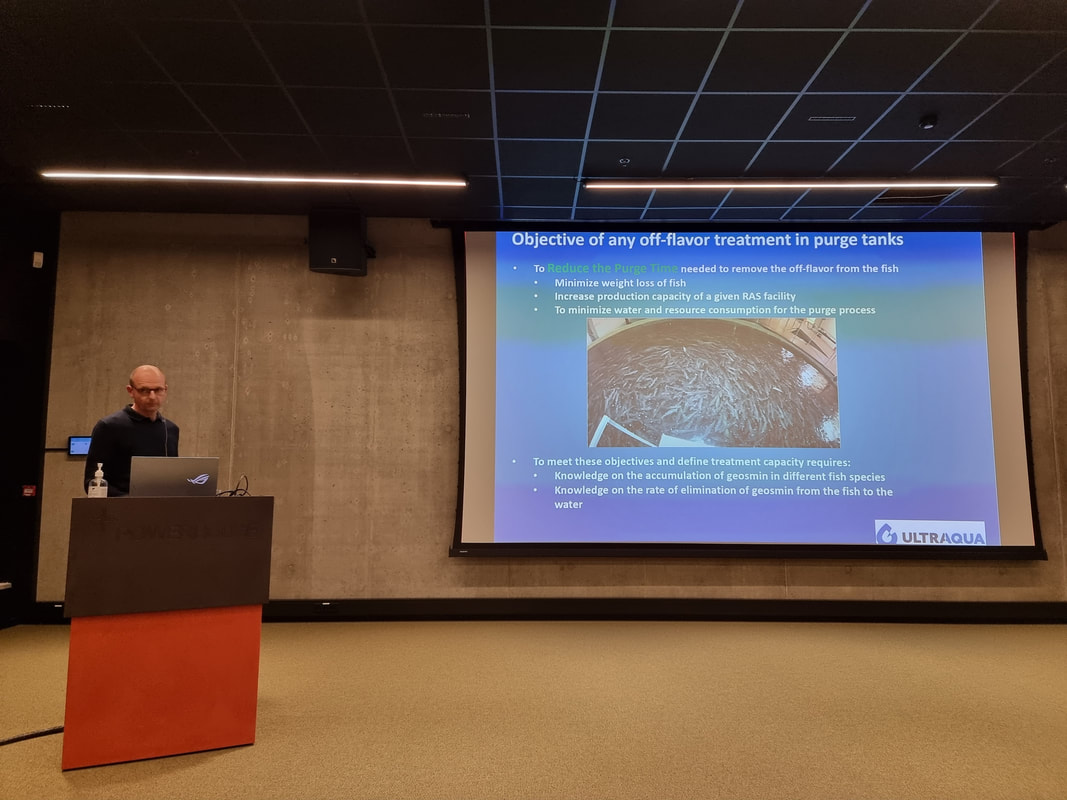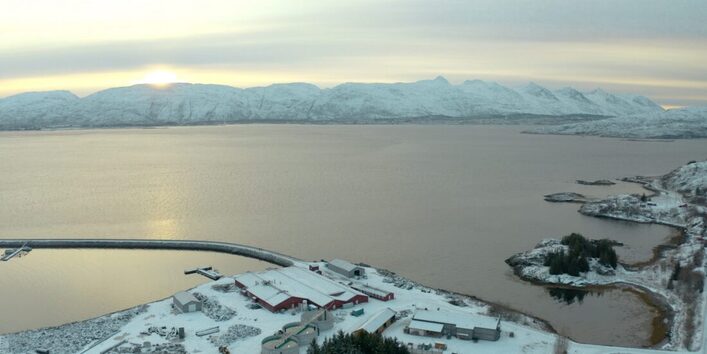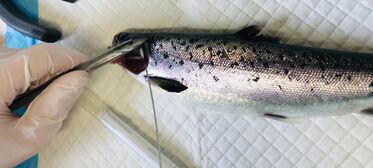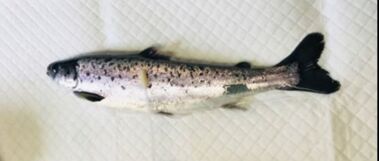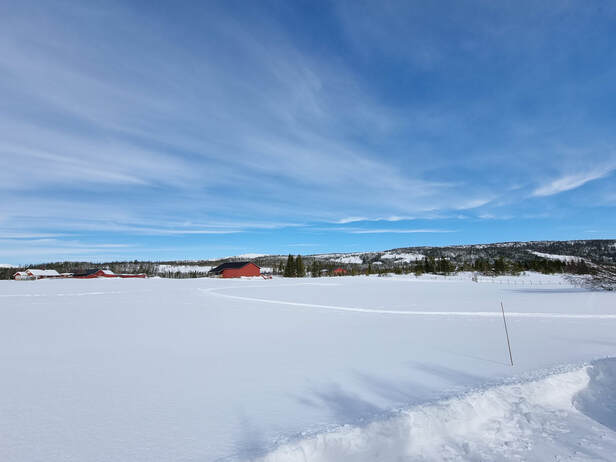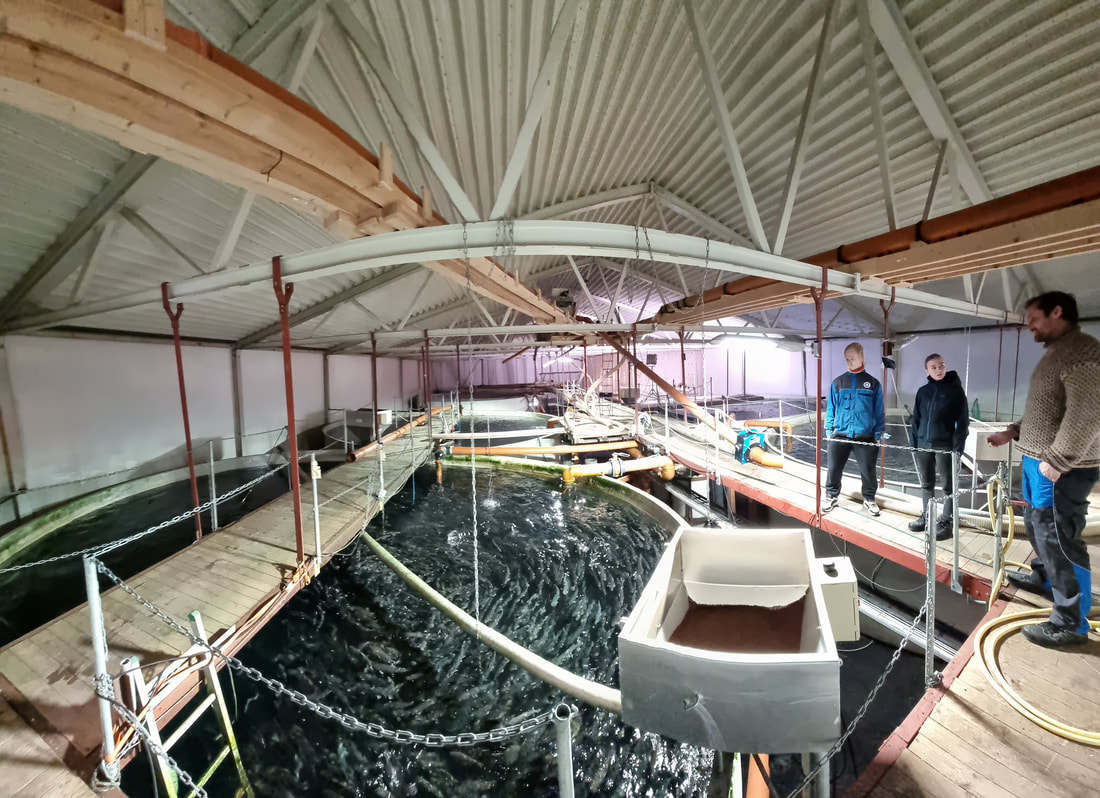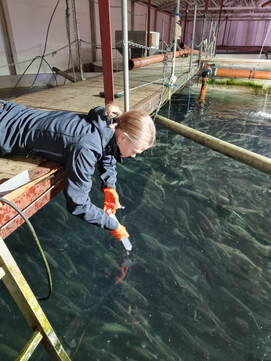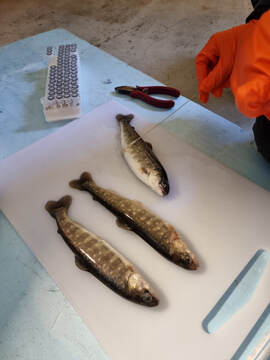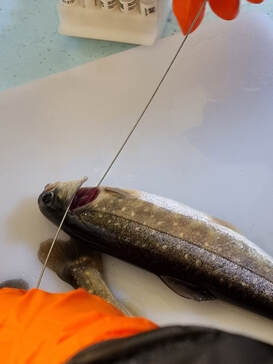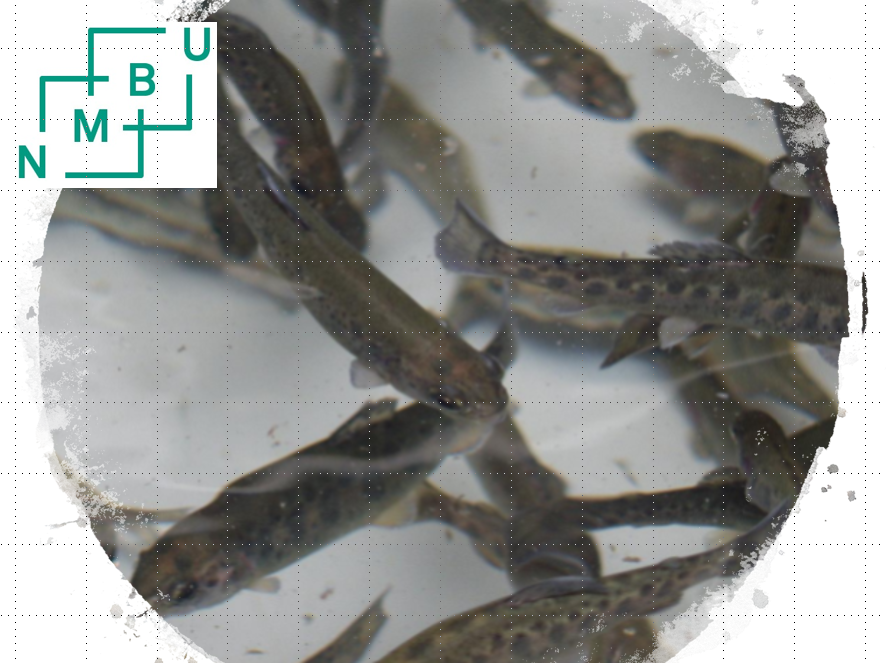In preparation for H2S fish challenge
20.06.2022
|
In closed aquaculture systems, hydrogen sulfide (H2S) formation poses a severe thread to fish health, welfare and development. Recently, several recirculating aquaculture systems (RAS) facilities have experienced incidents negatively affecting fish health, including mass mortality, supposedly to be caused by H2S produced by sulfate-reducing bacteria (SRB). Early life stages of salmon, such as parr and smolt are suspected to be particularly vulnerable to H2S. Despite the high operational and economic risk associated with H2S-related problems in the aquaculture sector, only very little is known about this complex topic and reliable data are scarce, especially when it comes to acute and chronic toxicity of H2S on salmon, but also the influence of it on microbial communities in RAS.
One of objectives in the DIGIRAS is to evaluate whether certain behavioural and water quality traits may be used as an early warning indicator of the toxic H2S in RAS. The central part of that objective is the upcoming H2S challenge with salmon smolt at our partner LetSea. Anecdotal information mention changes in fish behaviour, represented by alterations of swimming pattern, breathing frequency, or tail-beating rate when fish gets in contact with H2S. An under- and over-water camera system to monitor salmon smolt and recapture behavioural changes using advanced deep learning techniques is planned to be installed. Along that, machine vision deep learning algorithms and models need to be developed. In addition to fish monitoring, microbiological water quality will be assessed. We will evaluate how does global microbiota dynamics respond to H2S, and whether it can be used as a proxy to H2S in RAS. We hypothesis that sensitivity of microbial communities to changing environmental parameters may be exploited by application of supervised machine learning for producing models of high prediction accuracy. Both approaches aim to set basis for future research on reliable early warning approaches for detection of H2S in RAS. Such tools/approaches should have a potential for creating a "window of opportunity" for mitigation before fish health and welfare have been compromised. |
View from the top-down surveillance camera
View from the underwater stereo camera setup
|
DIGIRAS 6th EPG meeting
02.06.2022
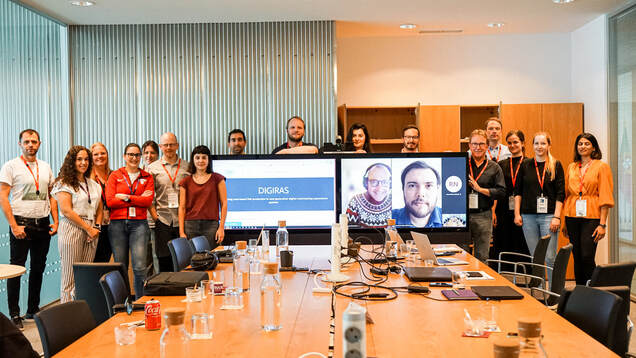
We have been hosted by our project partner INL for the 6th EPG meeting in Braga, Portugal.
Two days of fruitful dissemination and discussions on project activities and future directions went very quickly in such a delightful company.
More info on so-far project outcomes and plans is coming soon ...
Two days of fruitful dissemination and discussions on project activities and future directions went very quickly in such a delightful company.
More info on so-far project outcomes and plans is coming soon ...
Testing of advanced oxidation processes (AOP) for off-flavour combat
|
Off-flavors, compounds causing smell and taste described as “earthy” and “muddy”, are a serious problem in closed aquaculture systems. One of the most common compounds responsible for badly tasting fish is geosmin. It accumulates in fish tissue and changes its taste at the concentrations as low as 1ng/g of fish flesh. Commonly used practice in the aquaculture industry to remove off-flavors from fish is depuration. This process can take days to weeks and requires good quality water; hence fish are not fed. The disadvantages of this process are increased water use and loss of fish weigh, as a result generating financial losses.
One of the objectives of the project is to find an alternative solution that would be more economically sound and sustainable. Potential solutions are focused on elimination of off-flavors from RAS water, hence preventing their accumulation in fish. One of the approaches evaluated in DIGIRAS is the application of advanced oxidation processes (AOPs), like ozonation and photocatalysis over TiO2 for the degradation of geosmin. In spring 2022 Kinga Skalska from the LUT University conducted trials on the removal of geosmin from RAS water using commercially available reactor for photocatalytic oxidation (ENWA) and ozonation. Experiments performed at SINTEF OCEAN involved SINTEF Ocean SeaLab facility equipped with five miniRAS (part of SINTEF's national plankton center). Three MiniRAS units were used in the trials:
|
miniRAS units at SINTEF Ocean
Kinga preparing geosmin solution for spiking the miniRAS treatments
|
German partners networking
|
Julia, Tobias and Jörn, from CeBiTec at Bilefeld University have visited Fresh, our RAS farming partner in Saarland, Germany. They were hosted by the managing director Andreas and veterinarian/production biologist Eric. The facility is a full-scale marine RAS, producing Mediterranean seabream, Yellowtail kingfish and Whiteleg shrimp. In addition to commercial production, R&D is a big part of their activities. Fresh is located in the middle of continental Europe with no seawater around to be found for hundreds of kilometres, accentuating the potential of RAS for production of seafood on land (with no access to sea) and locally in urban areas (The Urban Blue Concept).
Based on photos provided, it seems that our German partners had a great time together, also with some taste buds being enticed with "local" cuisine :) |
DIGIRAS 5th EPG meeting
25.11.2021.
|
- The time has come for another executive project group (EPG) meeting, but now for the first time we were able to meet in person!
The meeting was held in Trondheim at SINTEF Ocean's SeaLab building, the coordinator of the DIGIRAS project. We've been unfortunate that DIGIRAS has launched in the midst of COVID-19 pandemic, and all the coordination between the partners had to be conducted remotely. Nevertheless, all the experimental work and monitoring activities were planned well and executed, and as of now, most of the sample collection at four RAS farms is finished. In WP1 and WP2, which are responsible for microbial community monitoring and development of new tools for targeted bacterial screening, first marker gene sequences were sequenced and analysed providing some exciting insights into microbial community dynamics of several RAS. Beforehand, our partners from CeBiTec at Bielefeld University were able to provide and host bioinformatics computing cloud for us. This infrastructure is part of the Elixir, the European bioinformatics network. WP3- The analytical methods for ultrasensitive determination of off-flavours and H2S are being established; so far, detection and quantification of the analytes is possible, but with limited reproducibility. The stability of the sample and the sample preparation procedure is being revised to improve the methodologies. On the other hand, we have developed, at a proof-of-concept stage and tested in laboratory, a new technology that allows to detect H2S at the low nM range using surface-enhanced Raman scattering sensing. We are now focused on the optimizations and development of the cartridge for measurements online before its validation with real matrix (RAS water). In WP4- fish behaviour, we have successfully built and tested a stereo vision camera system capable of tracking fish in 3D for looking at behavioural change via swimming speed and -synchronisation. A report has been written on the state of the art video analysis, the algorithms suggested in this paper has been implemented on the data acquired from the stereo vision system, initial results looks promising, but possible improvements to the camera system has been identified and will be implemented before next trial in February. WP5- Histopathological examination of important tissues (Liver, Spleen, Gut, and/or Kidney, and/or Gills) is performed, in order to assess the health status of the fish grown in RAS. Two populations of Dicendrarchus labrax and of Sparus aurata (one RAS per fish species), as well as one population of Seriola lalandi are being monitored. Up until now, sampling procedures of D. labrax and S. aurata is completed in RAS facilities, while the monitoring of the corresponding populations continued after the transportation of the fish in the sea cages. Sampling procedures concerning S. lalandi are continued up until March 2022. During the samplings performed in seabass and seabream RAS, water samples and biofilm samples (from tank water and biofilter carriers) were taken for the surveillance of protozoans commonly encountered in the specific aquaculture. In order to monitor stress level in fish, cortisol will be measured in samples of fish mucus and scales with Enzyme-linked immunosorbent assay (ELISA). At the moment the protocol for sample preparation and the corresponding analysis protocol are being established. WP6 WP7- Our newest member to the project , Postdoc Elia Ciani, will on behalf of NMBU leada acticities in WP7. This WP is crucial for combining all the results from other WPs and integrating them. As a first step, information about RAS designs and procedures have been obtained. In addition, automatic logs from the farms are collected. This information will be used to integrate physico-chemical data with data coming from microbiological screening in WP1. |
A snapshot from our first in-person executive project group meeting
Group photo of the project participants
SINTEF Sealab facility walkaround
|
DIGIRAS Workshop
24.11.2021
|
Within the framework of DIGIRAS project, we have organised a workshop on trends and innovations in RAS.
The workshop was held in Trondheim at SeeSalmon premises, featuring futuristic venue and emphasising sustainability for the future. The program was envisioned around four main thematic topics: "Fish'n risks", "Next in line", "HighRes and BigData", and "Blue and Green", covering subjects from fish health, new technologies, up to environmental sustainability in RAS industry. The workshop hosted 16 speakers and in total 65 participants. PDFs from all the talks are also available here. |
Activities at LetSea
23.04.2021
LetSea is Norway's largest private experimental and research centre for aquaculture, with infrastructure from small tanks to full-scale cages. The company farms mainly Atlantic salmon, Atlantic cod, and lumpfish. It has nine locations distributed in northern Norway and has its head office located at Sandnessjøen, surrounded by a mountain range called the seven sisters.
Atlantic salmon (Salmo salar) is an anadromous salmonid species widely distributed in the North Atlantic Ocean. The juveniles reside in freshwater for their early development and grow to smolt that undertakes downstream migration to the ocean to do feeding migration for several years. This fish is an extremely important commercial species; therefore, its sustainable farming is vital. LetSea has excellent experience working with Atlantic salmon and offers controlled research trials.
In the DIGIRAS project, LetSea is involved in mapping the microbial population, investigating the biological water quality, and examining fish behaviour during the production of Atlantic salmon grown in RAS. Both fish and environmental samples are collected. For fish samples, mucus from the fish skin, gills, and gut are taken. For environmental samples, water from the tanks and the source is collected; in addition to that, biofilm from the tanks and biofilter is taken to monitor the microbial development over time. For the first sampling regime, one cohort was targeted and followed for six months, with samples collected each month. Furthermore, LetSea will utilize its unique infrastructure to set up and run micro-RAS systems with camera technology to test different fish behaviour.
Atlantic salmon (Salmo salar) is an anadromous salmonid species widely distributed in the North Atlantic Ocean. The juveniles reside in freshwater for their early development and grow to smolt that undertakes downstream migration to the ocean to do feeding migration for several years. This fish is an extremely important commercial species; therefore, its sustainable farming is vital. LetSea has excellent experience working with Atlantic salmon and offers controlled research trials.
In the DIGIRAS project, LetSea is involved in mapping the microbial population, investigating the biological water quality, and examining fish behaviour during the production of Atlantic salmon grown in RAS. Both fish and environmental samples are collected. For fish samples, mucus from the fish skin, gills, and gut are taken. For environmental samples, water from the tanks and the source is collected; in addition to that, biofilm from the tanks and biofilter is taken to monitor the microbial development over time. For the first sampling regime, one cohort was targeted and followed for six months, with samples collected each month. Furthermore, LetSea will utilize its unique infrastructure to set up and run micro-RAS systems with camera technology to test different fish behaviour.
Microbial community profiling at NFFT
08.04.2021
Norwegian Fish Farms Tydal (NFFT) is a SME farming Arctic charr in RAS and FTS. It is situated in picturesque Tydal municipality between Sylan and Fongen mountain range in mid-Norway, close to the Swedish border.
Arctic charr (Salvenlius alpinus) is a salmonid species which is naturally occurring in surrounding cold rivers, where it has adapted to harsh and challenging environment after the polar ice caps have moved from today's land thousands years ago. Arctic charr can be of migratory or non-migratory life-style. Migratory is alternating between fresh and seawater (anadroumous), whereas, non-migratory remains for the whole life cycle in the freshwater. Sustainable and conscious source of Charr for the market can be found in small farms at many locations in Norway, NFFT being one of them.
Arctic charr (Salvenlius alpinus) is a salmonid species which is naturally occurring in surrounding cold rivers, where it has adapted to harsh and challenging environment after the polar ice caps have moved from today's land thousands years ago. Arctic charr can be of migratory or non-migratory life-style. Migratory is alternating between fresh and seawater (anadroumous), whereas, non-migratory remains for the whole life cycle in the freshwater. Sustainable and conscious source of Charr for the market can be found in small farms at many locations in Norway, NFFT being one of them.
|
For the purpose of DIGIRAS project and mapping of microbial community dynamics during production of Artic charr, screening of the RAS is performed. Samples from tank water, tank wall biofilm, biofilter biofilm and source water are collected. Additionally, samples from fish skin mucus, fish gill mucus and gut are taken.
For the first sampling three different cohorts of fish were targeted, ranging from 35g to 500g. These cohorts will be followed up for 6 months with samplings performed once a month. |
Job vacancy- Postodoctoral fellow within DIGIRAS
|
Department of Production Animal Medicine, Section for Animal Welfare, Epidemiology and Community Medicine at NMBU announces a vacancy for a postdoctoral fellow in aquaculture and epidemiology with a duration of 3 years.
We are looking for a person with an interest in both fish health and epidemiology. The position will be divided between two different projects. In one project, field trials will be carried out which the candidate will coordinate. In the second project, the candidate will be associated with the project «DIGIRAS», here NMBU's role is to link chemical and biological water quality data to clinically relevant fish health and production data. Common ground for both projects are coordination of sample collection, data processing and analysis. For more information about the position and application follow the link: www.jobbnorge.no/ledige-stillinger/stilling/199061/postdoktor-innen-epidemiologi-akvakultur?fbclid=IwAR30UzUrCoQCW0EcBatDRBdIzZzdTL5Z-SW0KNHBE4gu5oiuGWHTbGG9r-E |
1st EPG meeting
05.10.2020
EPG meeting took place including all partners and was headed by our project coordinator Dr. Roman Netzer.
Due to SARS-CoV pandemic and travel restrictions imposed, our meeting was conducted online.
Quick notes from the meeting:
EPG meeting took place including all partners and was headed by our project coordinator Dr. Roman Netzer.
Due to SARS-CoV pandemic and travel restrictions imposed, our meeting was conducted online.
Quick notes from the meeting:
- WP leaders presented planned work throughout the project and planned work for the rest of the year.
- One-on-one meetings between partners are encouraged, for a better coordination and workflow.
- Tentative plans for the sampling campaign for all 4 RAS facilities were discussed.
- Next EPG meeting was suggested to be held in December
DIGIRAS has started!
07.09.2020.
Project kick-off meeting took place including all partners and representatives of funding agencies. Due to SARS-CoV pandemic and travel restrictions imposed, our meeting was conducted online. The meeting was headed by our project coordinator Dr. Roman Netzer.
Short summary of the meeting:
Project kick-off meeting took place including all partners and representatives of funding agencies. Due to SARS-CoV pandemic and travel restrictions imposed, our meeting was conducted online. The meeting was headed by our project coordinator Dr. Roman Netzer.
Short summary of the meeting:
- After welcome note and introduction of all participants, ERA-NET BlueBio representatives Jella Kadziora and Kjell Emil Naas held a short presentation about BlueBio cofund, funding mechanisms and future perspectives.
- This was followed by a short presentation of all partner institutions.
- Dr. Netzer presented background for DIGIRAS project
- All WPs and activities have been presented by respective WP leaders.
- Finally, tentative dates have been proposed for next executive project group (EPG) and steering committee (SC) meeting.
- EPG meeting - tentative date in September
- SC meeting- tentative date in December
